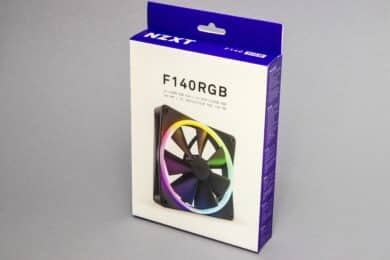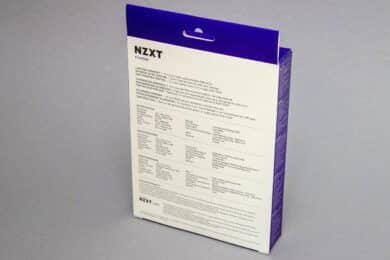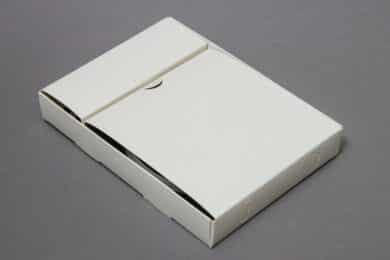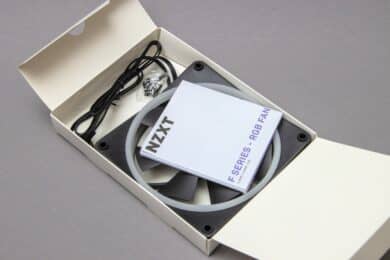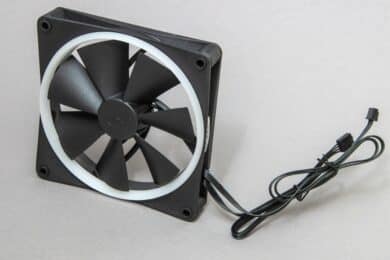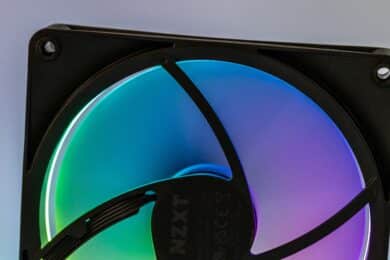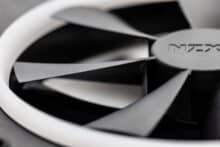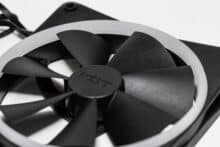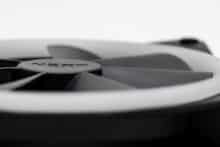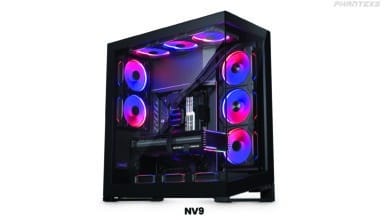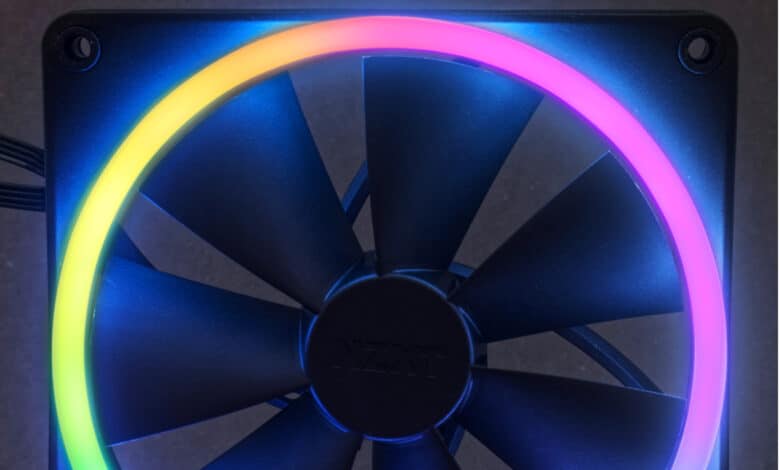
NZXT is known for its broad portfolio and the sale of computers under its own brand. The focus is always on a clear, clean design, which gives a high-quality appearance. And this is where the NZXT F140 RGB illuminated 140 mm fans come into play. In terms of price, these fans are aimed at the premium segment. We check here in the NZXT F140 RGB test how far they manage to meet expectations.
Specifications
| Size | 140 x 140 x 26 mm |
| Speed | 500 – 1800 RPM |
| Static pressure | max. 3.39 mm H2O |
| Airflow | max. 89.48 CFM |
| Noise level | max. 32.5 dB(A) |
| LEDs | 18 |
| Cable length | 60 cm |
| Expected runtime | 60,000 hours (almost 7 years continuous runtime) |
| Guarantee | 2 years |
| Price | € 28.99 * (black) € 29.99 * (white) |

Packaging and scope of delivery
- Clean packaging design
- Double protection thanks to second box
- Housing fan screws are included
The box is in the typical NZXT colors of white and purple. The strong design focus of the brand is again evident here: The front is very clear with the picture and the article name as well as basic information that it is a 140 mm RGB fan. All other information and specifications can be found on the back in several languages. A few rather meaningless advertising phrases are also printed in several languages on the sides, but are very unobtrusive.
If you open the box, you will see a second white box that you can pull out. If you pull the tabs here, you can see the fan on one side. Its cable and a packet of case fan screws are on the other, smaller side. A small manual is also included.
Design
- Very clean design on the front
- Unilluminated back is rather unspectacular
- Lighting shines towards the front
The NZXT F140 RGB also shows that the design aspect is a top priority at NZXT. The appearance of the fans is very clean, with soft edges, gentle shapes and no uneven interruptions. The shape of the fan blades is also kept very clear and they are only gently curved, with the edges being very straight and thus somewhat reminiscent of the fan blades of the Noctua NF-F12. Is the F in the article name a coincidence? The clearly rounded “corners”, which follow the shape of the screw holes, are particularly striking.
As far as the RGB lighting is concerned, this is only found on the frame, which is widened as a result. The fan blades are unlit and unfortunately the RGB ring is not continuous to the rear. This means that the rear is not illuminated and therefore most of the lighting shines towards the front. This can be both an advantage and a disadvantage. The similarly illuminated be quiet! Light Wings 140mm, for example, have a slightly better solution, even if the general design of the NZXT is cleaner.
In the center of the fan, the NZXT logo is stamped around the rather small motor area. Fortunately, the lettering on the back is kept inconspicuous in dark gray. Apart from that, the fan looks a little “unfinished” from behind and does not continue the clean design of the front. In short: The NZXT F140 RGB are fans that you want to see from the front.
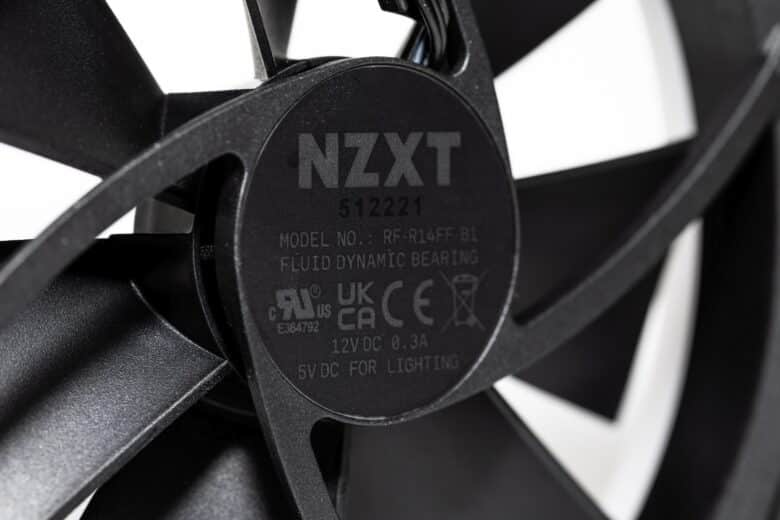
Build quality
- Workmanship appears high quality
- Relatively wide distance between the fan blades and the frame
- Full-length fan holes simplify installation with long screws
The workmanship in the NZXT F140 RGB test is of a very high quality. The plastic used for the frame appears solid and looks really good thanks to the matt surface structure.
The fan blades have a certain distance to the frame, which also protects against problems and the effects of manufacturing tolerances in the long term, but the performance could suffer a little. They are also slightly smaller than many other 140 mm fans, as the frame is slightly wider due to the RGB elements. Is this compensated for by the fact that the motor is kept particularly narrow, making the fan blades longer towards the middle? Probably not in terms of surface area.
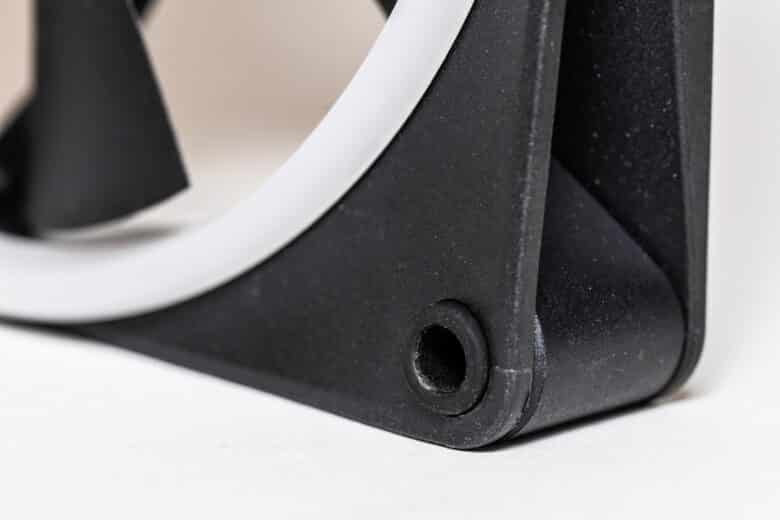
When mounting, it is convenient that the screw holes are continuous – so when mounting with long screws, you don’t have to worry about somehow getting through the opening at an angle and then having to fumble around until you are finally completely through.
Performance and volume
- Explanation of the test setups
- Test as a housing fan and on a radiator
- One test each at a uniform 800 RPM, at full power and low volume
In the NZXT F140 RGB test, there are two setups: a test on a radiator of an Arctic Liquid Freezer II 280 and a test as a case fan in a DeepCool CH510 Mesh Digital. Two fans are used in each case – in the radiator fan test, two fans fit on the heat sink, which sits in the front of a Fractal Design Pop XL, which means that the fans not only have the radiator as resistance, but also have to pull the air through the front grille. And in the case fan test, one fan is fitted at the rear and one at the bottom of the front.
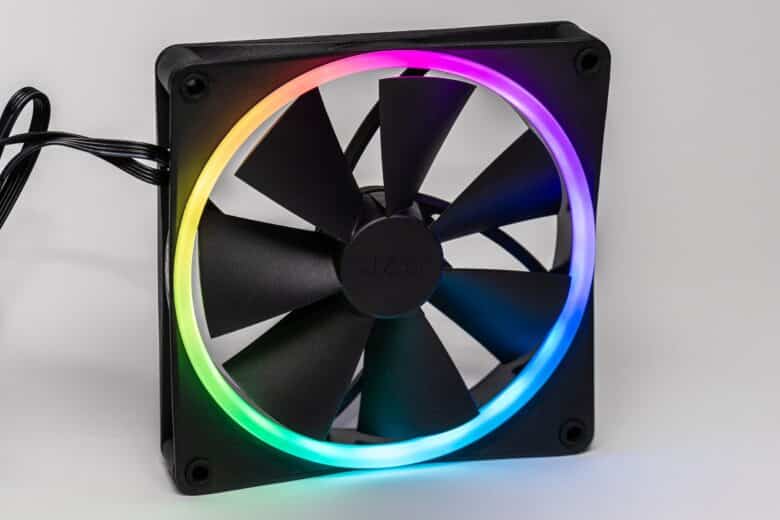
Three scenarios are tested in each test setup: One test at a uniform speed of 800 RPM, which on average is a good compromise between noise and performance. Secondly, a test at a uniformly calibrated low volume at the audibility limit, in which really quiet fans can show off their performance. Finally, there is the “all-or-nothing” test, in which the fans are turned up without limit. This scenario can occur automatically in everyday life, for example when modern processors take all the cooling power they can get. Or manually, for example in server systems in dedicated rooms, where the focus is less on volume and more on raw performance. The latter is not exactly the planned area of application for the NZXT F140 RGB, but cranking up the automatic settings is quite realistic.
NZXT F140 RGB test on the radiator
- Acceptable noise level
- Low performance as a radiator fan
In the NZXT F140 RGB test on the radiator at a uniform 800 RPM, the large fan unfortunately doesn’t perform well right from the start. The noise level is okay, but the performance is very low on the list.
However, even if the volume is okay, there are simply many other fans that are mercilessly outperformed in terms of radiator performance. These include the be quiet! Light Wings 140mm, which also come with an illuminated frame and black fan blades. On the AMD Ryzen 9 5950X, which draws just under 160W with an overclock and produces heat accordingly, the temperature with the NZXT F140 RGB was over four degrees above the competitor fan. On the latest generation of processors, which take all the cooling power they can get, this can certainly lead to a loss of performance. Other RGB fans that perform significantly better include the Corsair iCue AF140 RGB and the ENDORFY Fluctus 140 PWM ARGB.
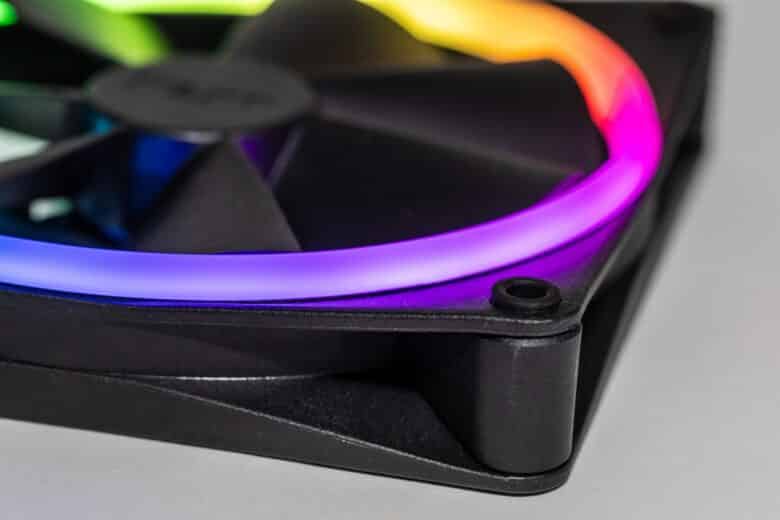
At full power, the NZXT F140 RGB doesn’t really look rosy in the test on the radiator either. Due to the high speed of around 1700 RPM, the fans are a little further forward here, but now only end up in the midfield, although there are many fans that are quieter, perform better – sometimes even both. The Lian Li Uni Fan AL140 V2, for example, is in a similar performance range, but is much quieter – and comes with more generous lighting and even an adapter to standard ARGB connections. The be quiet! Light Wings 140mm also perform slightly better and are much quieter. The already mentioned ENDORFY Fluctus achieve a noticeably better performance at a similar noise level.
Overall, not a good picture for the NZXT F140 RGB on the radiator.
Test as a case fan
- Mediocre performance
- Performance as a case fan okay, but not impressive
If you now pit a whole field of 140 mm fans against each other in a case, the NZXT F140 RGB is in the not really impressive lower midfield in the test at a uniform 800 RPM. A bit of a shame considering the price range.
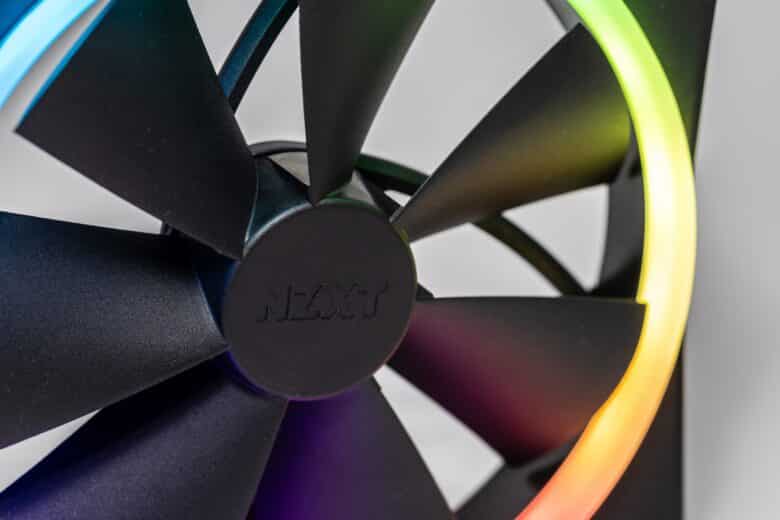
The problem is that they are not exactly among the quietest models. Accordingly, they don’t really fare any better against the competition in relative terms when it comes to use at a barely audible volume. Overall, the field is so close in terms of performance that it hardly makes a practical difference, but impressive is different. The design-like be quiet! Light Wings 140mm PWM with standard ARGB connection perform better. So do the cheaper Arctic P14 PWM PST A-RGB, but they have glowing fan blades and a black frame.
The NZXT F140 RGB performs better when operated at full power. Due to the high speed, these 140 mm fans are quite high up on the performance scale. However, there is a catch: the noise level is definitely no longer pleasant. For example, the Corsair iCue AF140 RGB Elite – also fans from a proprietary system – are noticeably louder at a slightly lower volume.
Overall, the NZXT F140 RGB fans are not very impressive, but are perfectly fine when used as case fans. So if you want to use them for the design and a uniform look, you can do so without any problems, but realistically you can also get more performance and quieter fans for less money.
Conclusion
The NZXT F140 RGB performs at a rather mixed level in the test. The workmanship looks okay and the design has a very clean charm – seen from the front. In terms of pure performance, however, these 140 mm fans are more in the lower class when it comes to radiator performance and at best in the lower middle class when tested as case fans. It’s a shame – this somewhat contradicts the expectations raised by the higher price range. Apart from that, you have to rely on a proprietary controller from NZXT for RGB control, as no adapter to standard ARGB is included.
NZXT F140 RGB
Processing
Equipment
Performance
Volume
Price-performance ratio
68/100
The NZXT F140 RGB are not outstanding fans. They can certainly be used as case fans, but you should steer clear of them on radiators.


